牛津五年级英语下册
- 格式:doc
- 大小:29.50 KB
- 文档页数:4

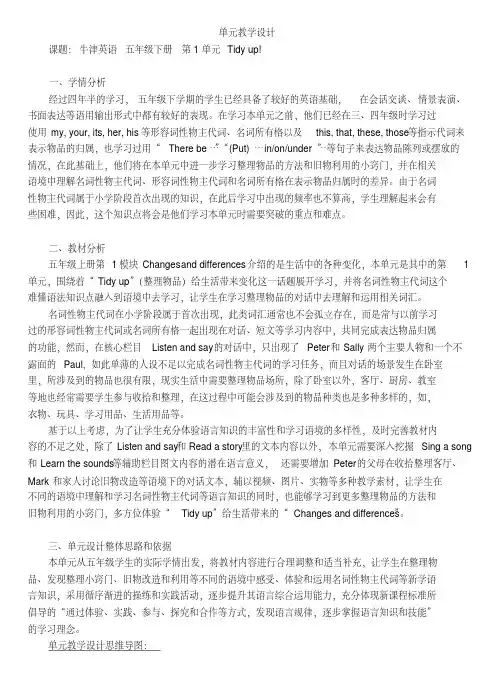
单元教学设计课题:牛津英语五年级下册第1单元Tidy up!一、学情分析经过四年半的学习,五年级下学期的学生已经具备了较好的英语基础,在会话交谈、情景表演、书面表达等语用输出形式中都有较好的表现。
在学习本单元之前,他们已经在三、四年级时学习过使用my, your, its, her, his等形容词性物主代词、名词所有格以及this, that, these, those等指示代词来”等句子来表达物品陈列或摆放的表示物品的归属,也学习过用“There be…”“(Put)…in/on/under…情况,在此基础上,他们将在本单元中进一步学习整理物品的方法和旧物利用的小窍门,并在相关语境中理解名词性物主代词、形容词性物主代词和名词所有格在表示物品归属时的差异。
由于名词性物主代词属于小学阶段首次出现的知识,在此后学习中出现的频率也不算高,学生理解起来会有些困难,因此,这个知识点将会是他们学习本单元时需要突破的重点和难点。
二、教材分析五年级上册第1模块Changes a nd differences介绍的是生活中的各种变化,本单元是其中的第1单元,围绕着“Tidy up”(整理物品)给生活带来变化这一话题展开学习,并将名词性物主代词这个难懂语法知识点融入到语境中去学习,让学生在学习整理物品的对话中去理解和运用相关词汇。
名词性物主代词在小学阶段属于首次出现,此类词汇通常也不会孤立存在,而是常与以前学习过的形容词性物主代词或名词所有格一起出现在对话、短文等学习内容中,共同完成表达物品归属的功能,然而,在核心栏目Listen and say的对话中,只出现了Peter和Sally两个主要人物和一个不露面的Paul,如此单薄的人设不足以完成名词性物主代词的学习任务,而且对话的场景发生在卧室里,所涉及到的物品也很有限,现实生活中需要整理物品场所,除了卧室以外,客厅、厨房、教室等地也经常需要学生参与收拾和整理,在这过程中可能会涉及到的物品种类也是多种多样的,如,衣物、玩具、学习用品、生活用品等。
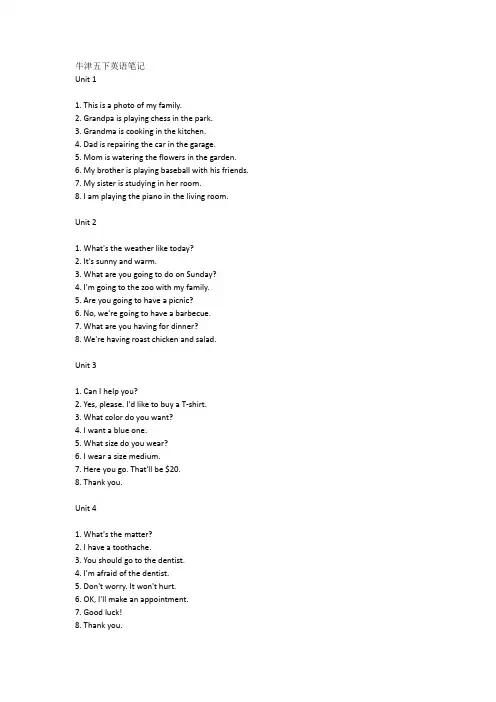
牛津五下英语笔记Unit 11. This is a photo of my family.2. Grandpa is playing chess in the park.3. Grandma is cooking in the kitchen.4. Dad is repairing the car in the garage.5. Mom is watering the flowers in the garden.6. My brother is playing baseball with his friends.7. My sister is studying in her room.8. I am playing the piano in the living room.Unit 21. What's the weather like today?2. It's sunny and warm.3. What are you going to do on Sunday?4. I'm going to the zoo with my family.5. Are you going to have a picnic?6. No, we're going to have a barbecue.7. What are you having for dinner?8. We're having roast chicken and salad.Unit 31. Can I help you?2. Yes, please. I'd like to buy a T-shirt.3. What color do you want?4. I want a blue one.5. What size do you wear?6. I wear a size medium.7. Here you go. That'll be $20.8. Thank you.Unit 41. What's the matter?2. I have a toothache.3. You should go to the dentist.4. I'm afraid of the dentist.5. Don't worry. It won't hurt.6. OK, I'll make an appointment.7. Good luck!8. Thank you.。
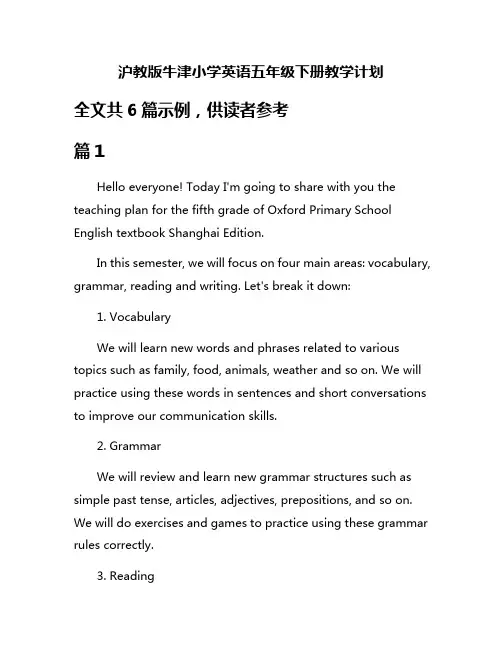
沪教版牛津小学英语五年级下册教学计划全文共6篇示例,供读者参考篇1Hello everyone! Today I'm going to share with you the teaching plan for the fifth grade of Oxford Primary School English textbook Shanghai Edition.In this semester, we will focus on four main areas: vocabulary, grammar, reading and writing. Let's break it down:1. VocabularyWe will learn new words and phrases related to various topics such as family, food, animals, weather and so on. We will practice using these words in sentences and short conversations to improve our communication skills.2. GrammarWe will review and learn new grammar structures such as simple past tense, articles, adjectives, prepositions, and so on. We will do exercises and games to practice using these grammar rules correctly.3. ReadingWe will read short stories, articles, and dialogues to improve our reading comprehension skills. We will discuss the main ideas, characters, settings, and themes of the texts to deepen our understanding.4. WritingWe will practice writing different types of texts such as letters, emails, diary entries, and short essays. We will focus on organizing our ideas, using appropriate vocabulary and grammar, and revising our work to make it more clear and coherent.In addition to these main areas, we will also have listening and speaking practice, group activities, projects, and games to make learning English fun and engaging.I hope you all are excited for the new semester and ready to learn and improve your English skills. Let's work hard together and have a great time in our English class!篇2Hello everyone! Today, I am going to share with you the teaching plan for the fifth grade of Oxford Primary School English in Shanghai. Let's have a look at what we will be learning this year!1. Learning Objectives- Improve listening, speaking, reading, and writing skills- Expand vocabulary and grammar knowledge- Enhance communication skills in English- Develop a deeper understanding of English culture and customs2. Teaching Materials- Oxford Primary School English textbooks for the fifth grade- Supplementary materials such as workbooks, flashcards, and online resources- Audio and visual aids to enhance learning3. Teaching Plan- Unit 1-3: Review previous knowledge, introduce new vocabulary and grammar structures- Unit 4-6: Learn about daily routines, hobbies, and interests- Unit 7-9: Explore different countries and cultures, practice speaking and writing skills- Unit 10-12: Focus on improving listening and reading comprehension, prepare for assessments4. Teaching Methods- Interactive activities such as role-plays, group discussions, and games- Use of multimedia resources to make learning enjoyable and engaging- Encourage students to participate actively in class and practice speaking English as much as possible5. Assessment and Evaluation- Weekly quizzes and tests to assess students' progress- Speaking and writing assignments to evaluate communication skills- End-of-term assessments to measure overall understanding of the materialIn conclusion, the fifth grade English curriculum at Oxford Primary School in Shanghai is designed to help students build a strong foundation in English language skills. By following this teaching plan and using a variety of resources and methods,students will be able to achieve success in their English studies. Let's have a great year of learning and fun together!篇3Hello everyone,I'm going to tell you about the teaching plan for the fifth grade Oxford Primary English course in Shanghai. Are you ready? Let's get started!First of all, we will start by reviewing what we learned in the fourth grade. We will review vocabulary, grammar rules, and reading comprehension. This will help us build a strong foundation for the new topics we will learn in the fifth grade.Next, we will learn new vocabulary related to topics such as food, animals, and hobbies. We will practice using this vocabulary in conversation and writing exercises. We will also learn new grammar rules, such as past tense verbs, comparatives and superlatives, and conditional sentences.In addition to vocabulary and grammar, we will focus on improving our reading and listening skills. We will read and listen to short stories, dialogues, and songs in English. We will practiceunderstanding the main ideas, details, and emotions in these texts.We will also work on improving our speaking and writing skills. We will practice having conversations with our classmates about different topics. We will write short paragraphs, letters, and stories using the vocabulary and grammar we have learned.Finally, we will review what we have learned throughout the year and prepare for the final exam. We will practice test-taking strategies and review all the material we have covered in class.I hope you are excited for the fifth grade Oxford Primary English course in Shanghai. Let's work hard and have fun learning English together!See you in class!篇4Hello everyone, I'm here to tell you about our teaching plan for the second semester of the fifth grade Oxford English textbook in Shanghai.First of all, we will continue to focus on the four skills of listening, speaking, reading, and writing. We will have moreopportunities for students to practice speaking and listening in pairs or groups, so they can improve their communication skills.In terms of reading, we will introduce more interesting and challenging texts to help students expand their vocabulary and improve their reading comprehension. We will also encourage students to read more English books or articles outside of class to further enhance their reading skills.For writing, we will continue to practice different types of writing, such as diary entries, descriptions, and stories. We will also focus on grammar and sentence structures to help students improve their writing ability.In addition, we will incorporate more fun activities and games into our lessons to make learning English more enjoyable and engaging for students. We will also organize more English-speaking activities, such as English corners, speech contests, and drama performances, to provide students with opportunities to use English in real-life situations.Overall, our goal is to help students become more confident and proficient in English communication. We hope that through our teaching plan, students will have a deeper understanding and appreciation for the English language and culture. Thank you for your attention!篇5Hey guys, today I'm gonna tell you about our teaching plan for the fifth grade! We'll be using the Shanghai Oxford English curriculum, which is super fun and exciting!First off, in our English class, we'll start by learning new words and phrases. We'll practice our pronunciation and make sure we understand the meaning of each word. Then, we'll move on to grammar and sentence structure. We'll learn how to put words together to make sentences that make sense.Next, we'll work on reading and comprehension. We'll read stories and passages together and make sure we understand what we've read. We'll also practice answering questions about the text to make sure we really get it.After that, it's time for some speaking and listening practice. We'll have conversations with our classmates and practice speaking in English. We'll also listen to recordings and videos to improve our listening skills.Finally, we'll finish off each lesson with some writing practice. We'll write short paragraphs, stories, and compositions to practice our writing skills and make sure we can express ourselves in English.our progress, and at the end of the year, we'll have a big final exam to see how much we've learned.I hope you guys are excited for our English class this year! Let's work hard and have fun learning English together!篇6Hi everyone! I'm so excited to tell you all about our teaching plan for the Oxford Primary English Grade 5 Book in Shanghai. It's gonna be super fun and we're gonna learn a lot of awesome stuff together!First off, we're gonna start by reviewing all the cool things we learned in Grade 4. We'll go over our grammar rules, vocabulary words, and practice our reading and writing skills. We'll have lots of games and activities to make learning fun and interactive!Next, we'll dive into the new topics of Grade 5. We'll learn about different cultures from around the world, explore interesting historical events, and discover how amazing our planet Earth is. We'll read interesting stories, write creative essays, and practice speaking English with our friends.to show off how much we've learned. We'll also have group activities and presentations to work on our teamwork and presentation skills. It's gonna be so much fun!And of course, we'll always make sure to have time for fun and games. We'll play English games, watch educational videos, and maybe even have a English mini-drama performance. Learning English is gonna be a blast!I can't wait to start our English journey together. Let's work hard, have fun, and become super awesome English speakers! See you all in class!。
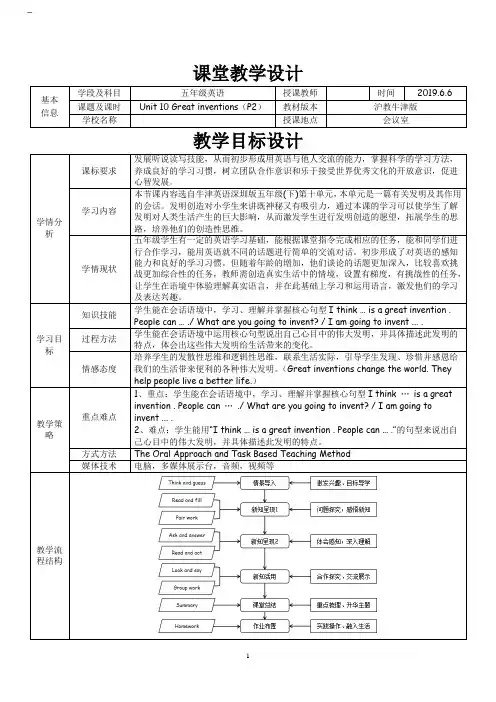
课堂教学设计 基本信息 学段及科目 五年级英语 授课教师 时间 2019.6.6 课题及课时Unit 10 Great inventions (P2) 教材版本 沪教牛津版学校名称 授课地点 会议室 教学目标设计 学情分析 课标要求 发展听说读写技能,从而初步形成用英语与他人交流的能力,掌握科学的学习方法,养成良好的学习习惯,树立团队合作意识和乐于接受世界优秀文化的开放意识,促进心智发展。
学习内容 本节课内容选自牛津英语深圳版五年级(下)第十单元,本单元是一篇有关发明及其作用的会话。
发明创造对小学生来讲既神秘又有吸引力,通过本课的学习可以使学生了解发明对人类生活产生的巨大影响,从而激发学生进行发明创造的愿望,拓展学生的思路,培养他们的创造性思维。
学情现状 五年级学生有一定的英语学习基础,能根据课堂指令完成相应的任务,能和同学们进行合作学习,能用英语就不同的话题进行简单的交流对话。
初步形成了对英语的感知能力和良好的学习习惯。
但随着年龄的増加,他们谈论的话題更加深入,比较喜欢挑战更加综合性的任务,教师需创造真实生活中的情境,设置有梯度,有挑战性的任务,让学生在语境中体验理解真实语言,并在此基础上学习和运用语言,激发他们的学习及表达兴趣。
学习目标 知识技能 学生能在会话语境中,学习、理解并掌握核心句型I think … is a great invention .People can … ./ What are you going to invent? / I am going to invent ... .过程方法 学生能在会话语境中运用核心句型说出自己心目中的伟大发明,并具体描述此发明的特点,体会出这些伟大发明给生活带来的变化。
情感态度 培养学生的发散性思维和逻辑性思维,联系生活实际,引导学生发现、珍惜并感恩给我们的生活带来便利的各种伟大发明。
(Great inventions change the world. Theyhelp people live a better life.)教学策略 重点难点 1、重点:学生能在会话语境中,学习、理解并掌握核心句型I think … is a great invention . People can … ./ What are you going to invent? / I am going to invent ... . 2、难点:学生能用“I think … is a great invention . People can … .”的句型来说出自己心目中的伟大发明,并具体描述此发明的特点。
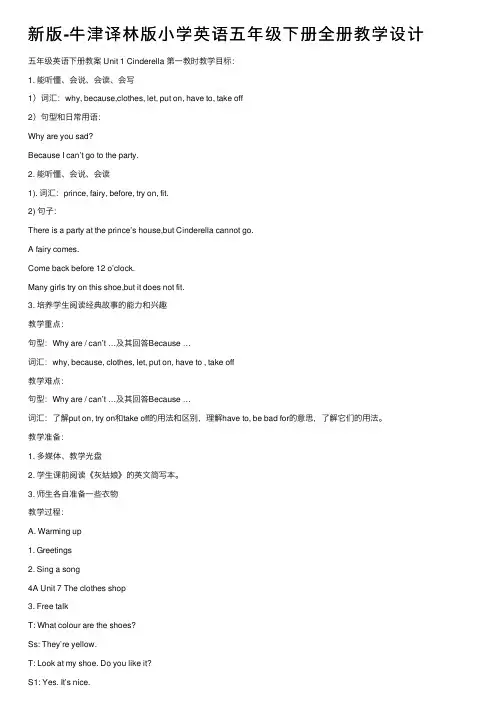
新版-⽜津译林版⼩学英语五年级下册全册教学设计五年级英语下册教案 Unit 1 Cinderella 第⼀教时教学⽬标:1. 能听懂、会说、会读、会写1)词汇:why, because,clothes, let, put on, have to, take off2)句型和⽇常⽤语:Why are you sad?Because I can’t go to the party.2. 能听懂、会说、会读1). 词汇:prince, fairy, before, try on, fit.2) 句⼦:There is a party at the prince’s house,but Cinderella cannot go.A fairy comes.Come back before 12 o’clock.Many girls try on this shoe,but it does not fit.3. 培养学⽣阅读经典故事的能⼒和兴趣教学重点:句型:Why are / can’t …及其回答Because …词汇:why, because, clothes, let, put on, have to , take off教学难点:句型:Why are / can’t …及其回答Because …词汇:了解put on, try on和take off的⽤法和区别,理解have to, be bad for的意思,了解它们的⽤法。
教学准备:1. 多媒体、教学光盘2. 学⽣课前阅读《灰姑娘》的英⽂简写本。
3. 师⽣各⾃准备⼀些⾐物教学过程:A. Warming up1. Greetings2. Sing a song4A Unit 7 The clothes shop3. Free talkT: What colour are the shoes?Ss: They’re yellow.T: Look at my shoe. Do you like it?S1: Yes. It’s nice.T: Please try it on.S1: (学⽣试穿鞋⼦) Oh, it’s too big.B. Presentation and practice1. 说说做做,学习新词呈现⼀些⾐物,并做试穿、脱下的动作,引导学⽣学习、理解新词put on, take off, try on 和fit. T: (呈现⼀件衬衫) Here’s a shirt. It looks nice. Let me try it on. Look. What do you think?S1: It’s small.T: You are right. It’s a bit small. It doesn’t fit.Ss: It doesn’t fit.T: OK. Let me take it off.Ss: Take it off.T: (呈现⼀顶帽⼦) What about this cap? Let me put it on.Ss: Put it on.T: It’s not small. It’s not big either. It’s just right. It fits.Ss: It fitsT: Would you like to try on this cap?S1:(戴上帽⼦)OK.T: Does it fit?S: No. it’s big.T: Please take it off2. 试穿活动,操练⽬标词汇学⽣拿出准备的⾐物,两⼈⼀组进⾏听⼝令、做动作,操练⽬标词汇S1: Put on this coat, please.S2: OK.S1: Does it fit?S2: No, it doesn’t. it’s too big.S1: Please take it off.3. 师⽣问答,学习why和because继续⾐物试穿活动,师⽣问答,学习疑问副词why和表⽰原因的连词because.T: I like this dress. Why? Because it’s blue. I like blue. Do you like this dress?S1: Yes, I do.T: Why?S1: Because it’s blue. I like blue.T: Why do I like this dress?Ss: Because it’s blue.T: Why does he / she like this dress?Ss: Because he / she likes blue.…4. ⼩组活动,操练why和because学⽣两⼈⼀组,就⼿中的⾐物进⾏问答,操练why和becauseS1: Do you like this shirt?S2: Yes, I do.S1: Why do you like it?S2: Because it looks cool.S1: Do you like these shoes?S2: No, I don’t.S1: Why?S2: Because they don’t fit. They’re too big.…C. Story time1. 介绍故事⼈物和场景多媒体呈现课⽂中的图⽚,简介故事⼈物,适当拓展词汇T: (呈现王⼦图⽚)Look at t his young man. He’s the son of the king. He’s a prince.He’s tall and handsome.(呈现课⽂第⼀幅图⽚)There are four women in this picture. One is old, the other three are young. This girl is Cinderella. She lives with her stepmother and two stepsisters. She’s a beau tiful girl. She does the housework in the kitchen all day, so she looks dirty. Her two stepsisters always wear beautiful clothes, but they’re lazy and ugly. They don’t do the housework. They always ask Cinderella to help them.(呈现课⽂第⼆幅图⽚)This woman is a fairy. She can fly. She has a magic stic. She can play magic.2. 引导学⽣读读教材P8 Ask and answer中的问题,然后⾃读课⽂并划出问题答案的相关语句。
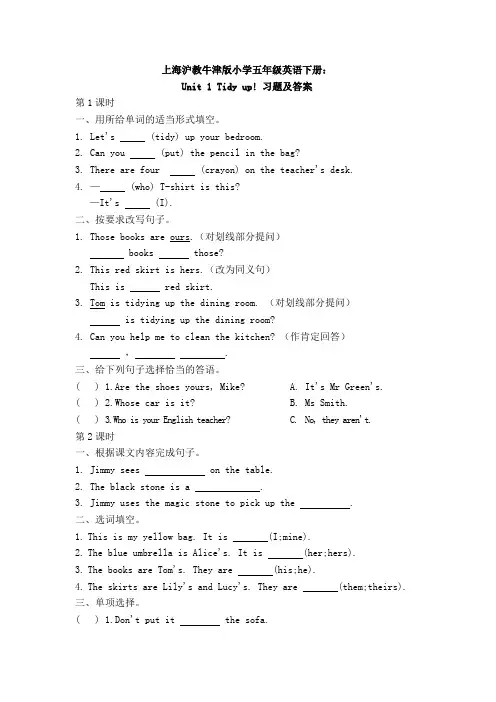
上海沪教牛津版小学五年级英语下册:Unit 1 Tidy up! 习题及答案第1课时一、用所给单词的适当形式填空。
1. Let's (tidy) up your bedroom.2. Can you (put) the pencil in the bag?3. There are four (crayon) on the teacher's desk.4. — (who) T-shirt is this?—It's (I).二、按要求改写句子。
1. Those books are ours.(对划线部分提问)books those?2. This red skirt is hers.(改为同义句)This is red skirt.3. Tom is tidying up the dining room. (对划线部分提问)is tidying up the dining room?4. Can you help me to clean the kitchen? (作肯定回答), .三、给下列句子选择恰当的答语。
( ) 1.Are the shoes yours, Mike? A. It's Mr Green's.( ) 2.Whose car is it? B. Ms Smith.( ) 3.Who is your English teacher? C. No, they aren't.第2课时一、根据课文内容完成句子。
1. Jimmy sees on the table.2. The black stone is a .3. Jimmy uses the magic stone to pick up the .二、选词填空。
1.This is my yellow bag. It is (I;mine).2.The blue umbrella is Alice's. It is (her;hers).3.The books are Tom's. They are (his;he).4.The skirts are Lily's and Lucy's. They are (them;theirs).三、单项选择。
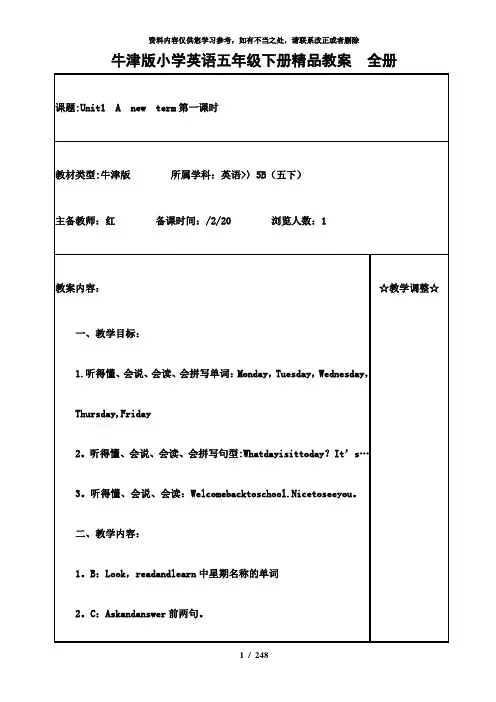
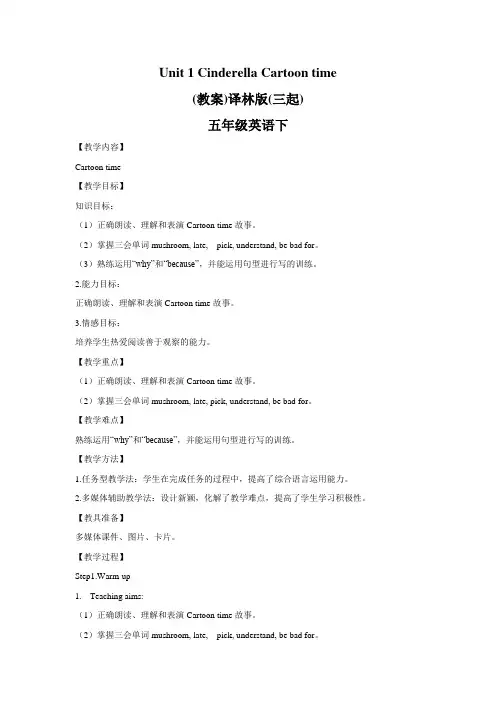
Unit 1 Cinderella Cartoon time(教案)译林版(三起)五年级英语下【教学内容】Cartoon time【教学目标】知识目标:(1)正确朗读、理解和表演Cartoon time故事。
(2)掌握三会单词mushroom, late, pick, understand, be bad for。
(3)熟练运用“why”和“because”,并能运用句型进行写的训练。
2.能力目标:正确朗读、理解和表演Cartoon time故事。
3.情感目标:培养学生热爱阅读善于观察的能力。
【教学重点】(1)正确朗读、理解和表演Cartoon time故事。
(2)掌握三会单词mushroom, late, pick, understand, be bad for。
【教学难点】熟练运用“why”和“because”,并能运用句型进行写的训练。
【教学方法】1.任务型教学法:学生在完成任务的过程中,提高了综合语言运用能力。
2.多媒体辅助教学法:设计新颖,化解了教学难点,提高了学生学习积极性。
【教具准备】多媒体课件、图片、卡片。
【教学过程】Step1.Warm-up1.Teaching aims:(1)正确朗读、理解和表演Cartoon time故事。
(2)掌握三会单词mushroom, late, pick, understand, be bad for。
(3)熟练运用“why”和“because”,并能运用句型进行写的训练。
2.Let’s review(1)以Wh-开头的特殊疑问词归纳Whose 询问什么人的Who 询问人Why 询问为什么What 询问东西或者事情When 询问时间Where 询问地点(2)以Why 引导的特殊疑问句,用Because加上表示原因的句子给出回答。
(3)复习Fun time内容,看图对话Picture1: Why can’t I go to the party?Because you don’t have any nice clothes and shoes.Picture2: You’re sad, dear. Why?Because I can’t go to the party.Why can’t you go to the party?Because I don’t have any nice clothes and shoes.Picture 3: I have to go now.Why?Because I have to go back before 12 o’clock.Picture 4: Oh, my foot hurts!Why?Because it doesn’t fit.Step2 Presentation1.Look and answerAre they happy? No.Why? Guess!呈现Cartoon time第一幅图和对话内容,教学的同时让学生找出答案:hungry Teach: I’m hungry. 我很饿。
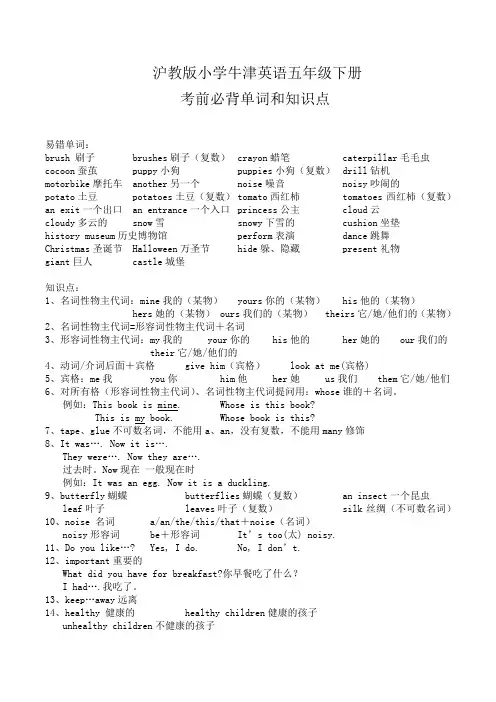
沪教版小学牛津英语五年级下册考前必背单词和知识点易错单词:brush 刷子brushes刷子(复数)crayon蜡笔caterpillar毛毛虫cocoon蚕茧puppy小狗puppies小狗(复数)drill钻机motorbike摩托车another另一个noise噪音noisy吵闹的potato土豆potatoes土豆(复数)tomato西红柿tomatoes西红柿(复数)an exit一个出口an entrance一个入口princess公主cloud云cloudy多云的snow雪snowy下雪的cushion坐垫history museum历史博物馆perform表演dance跳舞Christmas圣诞节Halloween万圣节hide躲、隐藏present礼物giant巨人castle城堡知识点:1、名词性物主代词:mine我的(某物)yours你的(某物)his他的(某物)hers她的(某物) ours我们的(某物)theirs它/她/他们的(某物)2、名词性物主代词=形容词性物主代词+名词3、形容词性物主代词:my我的 your你的his他的her她的 our我们的their它/她/他们的4、动词/介词后面+宾格give him(宾格)look at me(宾格)5、宾格:me我you你him他her她us我们them它/她/他们6、对所有格(形容词性物主代词)、名词性物主代词提问用:whose谁的+名词。
例如:This book is mine. Whose is this book?This is my book. Whose book is this?7、tape、glue不可数名词,不能用a、an,没有复数,不能用many修饰8、It was…. Now it is….They were…. Now they are….过去时。
Now现在一般现在时例如:It was an egg. Now it is a duckling.9、butterfly蝴蝶butterflies蝴蝶(复数)an insect一个昆虫leaf叶子leaves叶子(复数)silk丝绸(不可数名词)10、noise 名词a/an/the/this/that+noise(名词)noisy形容词be+形容词It’s too(太) noisy.11、D o you like…?Yes, I do. No, I don’t.12、important重要的What did you have for breakfast?你早餐吃了什么?I had….我吃了。
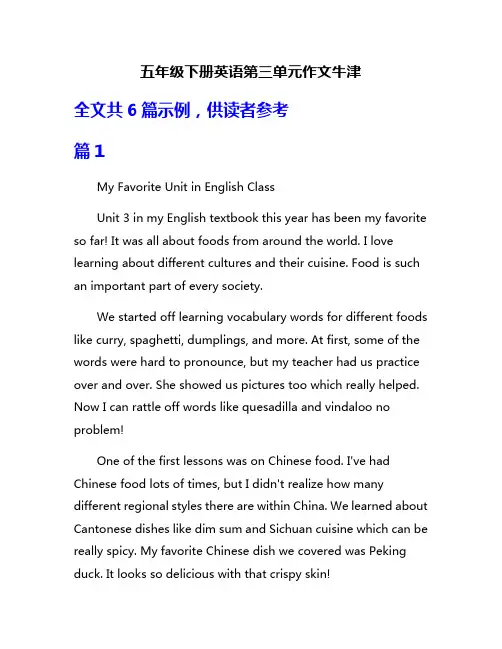
五年级下册英语第三单元作文牛津全文共6篇示例,供读者参考篇1My Favorite Unit in English ClassUnit 3 in my English textbook this year has been my favorite so far! It was all about foods from around the world. I love learning about different cultures and their cuisine. Food is such an important part of every society.We started off learning vocabulary words for different foods like curry, spaghetti, dumplings, and more. At first, some of the words were hard to pronounce, but my teacher had us practice over and over. She showed us pictures too which really helped. Now I can rattle off words like quesadilla and vindaloo no problem!One of the first lessons was on Chinese food. I've had Chinese food lots of times, but I didn't realize how many different regional styles there are within China. We learned about Cantonese dishes like dim sum and Sichuan cuisine which can be really spicy. My favorite Chinese dish we covered was Peking duck. It looks so delicious with that crispy skin!Then we moved on to Italian food. Who doesn't love pasta? We read about how different shapes of pasta go with different sauces. I had no idea there were so many varieties! We also learned about Italian pizza, gelato, and wines from different regions. By the end, I was craving a big bowl of spaghetti carbonara.Mexican cuisine was another focus. I love Mexican food already, but learning more about authentic dishes from different parts of Mexico was eye-opening. Mole sauce seems incredibly complex to make with all those ingredients. The chorizo sausage they use also sounds delicious. I'll have to ask my parents to take me to a authentic Mexican restaurant soon.One fun lesson was about French foods. I didn't know that many of the words we use in English actually came from French culinary terms. Words like à la carte, hors d'oeuvres, and soufflé. No wonder those are hard to spell! We read about French delicacies like escargot (cooked snails), foie gras (fattened duck liver), and intricate desserts. I'm not sure I'd want to try those, but I'd love to visit a French bakery someday.Toward the end of the unit, we also covered Caribbean and South American cuisines. I had never really tried foods from those regions before. The use of tropical fruits and vegetableswas so vibrant and flavorful. Reading about ackee, plantains, yuca, and arepas made my mouth water. The grilled meats and fish with zesty lime and Caribbean spice rubs sounded delicious as well. I'll definitely be keeping an eye out for Caribbean or South American restaurants to try.My absolute favorite part was the final project for the unit - a multicultural potluck party! Every student had to make or bring in a dish representing a different country or culture. Seeing the smorgasbord of colors, aromas, and textures was incredible. From egg rolls to samosas, empanadas to falafel, it was a true feast for the senses. Trying all my classmates' dishes was a culinary adventure!I still remember how delicious Jayden's homemade chicken tikka masala was. The spices were potent but not overpowering. Sofia's family made authentic Chilean empanadas that melted in your mouth. Chloe's French crêpes with Nutella were to die for too! In the end, we all left with full bellies and an appreciation for all the diverse and delectable foods the world has to offer.This unit on international foods was not only fun and engaging, but also educational. I learned so much about culinary traditions, flavor profiles, signature ingredients, and cultural significance of foods. Studying these foods in such depth reallysparked my curiosity to travel more and experience other cultures firsthand.I have a much broader palate now and am willing to try unique dishes instead of sticking to my usual favorites. Going forward, I'll value the specialness of eating authentic, ethnic cuisines made from treasured recipes. Food is a universal language that brings people together across all boundaries. After this unit, I feel I can navigate a world menu with more cultural understanding and culinary expertise. Bon appétit!篇2My Favorite Unit: Animals in ActionUnit 3 in our fifth grade English textbook this year was all about animals, and it was definitely my favorite unit so far! I've always loved learning about different animals and their amazing abilities. This unit taught me so many fascinating facts that I can't wait to share with you.We started off learning about how animals communicate in some very unique ways. Did you know that elephants can communicate over long distances by making low rumbling noises that humans can't even hear? Their calls can travel for miles through the ground and air. Whales also have amazingcommunication by singing haunting songs and clicking noises underwater. I thought it was so cool learning about the different ways animals "talk" to each other.My favorite lesson was definitely the one on animal migrations. I was blown away by the incredible journeys that some animals take every single year. The Arctic tern migrates around 50,000 miles annually, which is more than any other animal on the planet! That's the equivalent of going all the way around the world twice. I can't even imagine having to fly that far carrying just my backpack, let alone flying with all my food and supplies like the Arctic tern has to do.We learned about other epic migrations too, like the wildebeest migration in Africa where over a million wildebeests travel 500 miles through Kenya and Tanzania following the rains. Or the Christmas Island red crab migration where 120 million bright red crabs travel from the interior of the islands all the way to the ocean to release their eggs in one of the mostmind-blowing events in nature. Seeing photos and videos of these mass movements of animals was just breathtaking.Another highlight for me was studying different defense mechanisms that animals have developed to protect themselves from predators. Some examples we looked at included theporcupine's needle-sharp quills, the skunk's potent stinky spray, and the bombadier beetle that can actually release a boiling hot chemical vapor from its body! My personal favorite was the strange defense of the hagfish - it ties itself into a knot and then produces tons of sticky slime to make predators release their grip. Gross but effective!We had so much fun with a creative writing assignment where we had to invent our own new animal defense mechanism.I designed "The Buzzard" - a big ugly bird that vomits afoul-smelling black goo on any animal that tries to attack its nest. The goo hardens like cement, trapping the predator until other Buzzards can come and finish it off. I got an A+ on that one!Towards the end of the unit, we studied the phenomenon of animal mimicry and camouflage. The photos we saw ofleaf-tailed geckos, stick insects, and other masters of disguise just boggled my mind. How crazy that some animals have basically turned invisibility into an art form just to stay alive! My favorite was the mimic octopus that can contort its body to take on the shapes and movements of over 15 different species like sea snakes, shrimp, starfish and more. If I could shape-shift like that, I would have so much fun pranking my friends and family.Overall, Unit 3 was such an eye-opening experience learning about the secret lives of the animal kingdom. I'll never look at animals the same way again after discovering their genius ways of communicating, migrating, defending themselves, and hiding in plain sight. I'm really hoping we get to learn about some more amazing animal abilities in future units because this stuff just fascinates me to no end. Who would have thought English class could be this wild?篇3My Favorite Unit So FarUnit 3 in our Oxford English textbook this year has definitely been my favorite unit so far. It was all about sports and staying active, which are two things I really love. The unit started off with a cool reading about the history of the Olympic Games. I thought it was really fascinating to learn about how the Olympics started way back in ancient Greece. The passage talked about how the ancient Greeks held the first Olympic Games in 776 B.C. in a place called Olympia. Only male athletes from Greek cities were allowed to compete back then. The events included running, wrestling, boxing, and chariot racing among others. I can't even imagine having to race chariots pulled by horses!After the ancient Olympic Games were banned in the 4th century A.D., there was a really long gap of over 1,500 years until the modern Olympic Games started up again in 1896. The first modern Olympics took place in Athens, Greece. One big difference is that the modern Games are open to athletes from all over the world, not just Greeks. And female athletes are included too, which I'm really glad about. It's hard to believe women weren't allowed to even watch the ancient Olympics as spectators! The reading passage mentioned some other cool facts too, like how the Olympic flame is still lit by the sun's rays at the ancient ruins of Olympia before each Olympics and then relayed to the host city.Learning the history of the Olympics was really interesting, but my favorite part of Unit 3 was the section on different sports and being active. We learned lots of new vocabulary related to sports, like words for different ball games, athletic equipment, venues where sports take place, and actions used in sports. I already knew words like "dribble" and "pitch" from playing basketball and baseball. But I learned new words too like "bout" for a boxing or wrestling match. My favorite new word was "regatta" which means a boat racing competition. It sounds like such a fun word.We also read a really inspiring article about Wilma Rudolph, who was an African American track and field athlete in the 1960s. When Wilma was just a little kid, she got very sick with polio and pneumonia. The diseases caused her to lose strength in her left leg and foot. The doctors even told her parents that she might never be able to walk again! But Wilma worked super hard, doing physical therapy exercises for years, until she slowly regained use of her leg and foot. By the time she was a teenager, she wasn't just walking but running too—and incredibly fast!Wilma started training as a runner and went on to compete in the 1956 and 1960 Olympic Games. In 1960, she made history by becoming the first American woman to win three gold medals in a single Olympics. The article said Wilma loved running because it made her feel free and powerful, like she could "fly over the ground." Her amazing story of overcoming so many challenges really inspired me. If Wilma could work that hard and never give up on her dream, it motivates me to keep practicing at whatever I'm struggling with too.Along with all the great readings and vocabulary, Unit 3 also had lots of speaking practice activities that were really fun. My favorite was when we did role plays pretending to interview famous athletes. I got to play the part of Serena Williams beinginterviewed after winning her 23rd Grand Slam tennis title. I tried to give confident, determined answers just like I imagine Serena would. For example, my friend asked me "To what do you attribute your incredible success over the years?" And I responded "My unbelievable work ethic and never-say-die attitude. I train harder than anyone out there." It was a blast trying to get into character as one of the greatest athletes ever!In another entertaining activity, we had to debate which sports deserve more sponsorship and funding. I was on the team arguing that youth sports programs for kids should get more financial support from sponsors. I said that getting kids active and interested in sports at a young age helps them build healthy habits for life. It also teaches important values like teamwork, determination, and how to handle wins and losses. My argument must have been pretty convincing because my team ended up winning that debate!Overall, Unit 3 was packed with so many engaging activities, readings, games, and opportunities to use new vocabulary. I feel like my English skills really improved, especially my speaking and reading comprehension. But most importantly, the whole unit got me excited about living an active, healthy lifestyle and maybe even pursuing a sport I love in the future. Why sit insideall day when you could be out playing soccer, swimming, or running like Wilma Rudolph? This unit reminded me how fun and empowering it can be to get out there and get moving. I can't wait to see what awesome topics are coming up in the next unit of our textbook!篇4My Exciting Adventures with Unit 3Hi there! My name is Emma, and I'm a fifth-grader at Maple Grove Elementary School. Today, I want to share my experience with Unit 3 of our English textbook, which has been an absolute blast! Get ready for some exciting adventures!It all started when our teacher, Mrs. Johnson, introduced us to the topic of "Exploring the Great Outdoors." I have to admit, at first, I wasn't too thrilled about the idea. After all, I'm more of an indoor kid who loves reading books and playing video games. But little did I know that this unit would change my perspective forever!The first thing we did was learn all about different outdoor activities like hiking, camping, and rock climbing. I was amazed by the stunning pictures in our textbook, showcasingbreathtaking mountain ranges, crystal-clear lakes, and lush forests. It was like stepping into a whole new world!One of the coolest parts of this unit was when we learned about survival skills. We practiced building shelters, starting a campfire (safely, of course), and even learned how to purify water in the wilderness. It was like being on a real-life adventure show!But the best part was when Mrs. Johnson announced that we were going on a class field trip to a nearby nature reserve. I was both excited and a little bit nervous, but I knew it would be an experience to remember.The day of the field trip arrived, and we all piled onto the school bus, buzzing with anticipation. As we stepped off the bus and into the lush greenery, I felt like I had been transported to a different world. The fresh air, the chirping birds, and the rustling leaves all around us – it was pure magic.Our first activity was a guided nature hike, where we learned about the different plants and animals that call this place home. I was fascinated by the intricate details our guide shared, like how certain trees can live for hundreds of years and how some animals use camouflage to blend in with their surroundings. It was like being a part of a real-life nature documentary!After the hike, we had a picnic lunch in a beautiful clearing. As I munched on my sandwich, I couldn't help but feel a deep sense of peace and tranquility. It was a stark contrast to the hustle and bustle of our everyday lives back in the city.In the afternoon, we had a chance to try our hands at setting up tents and building campfires (under the watchful eye of our teachers, of course). It was a lot more challenging than I thought, but the sense of accomplishment I felt when my tent was finally standing tall was indescribable.As the day drew to a close, we gathered around the campfire and sang songs, swapped stories, and roasted marshmallows. It was the perfect way to cap off our adventure, surrounded by the warmth of the fire and the camaraderie of our classmates.On the bus ride back home, I couldn't stop thinking about all the amazing things we had experienced. I realized that exploring the great outdoors wasn't just about learning new skills or acquiring knowledge – it was about connecting with nature, stepping out of our comfort zones, and creating lasting memories with our friends and teachers.Ever since that field trip, I've developed a newfound appreciation for the beauty of the natural world. I've even startedgoing on hikes with my family on the weekends, and I'm planning to join the school's outdoor club next year.Unit 3 of our English textbook may have been about exploring the great outdoors, but for me, it was so much more than that. It was a journey of self-discovery, a chance to step out of my comfort zone and embrace new experiences. And for that, I'll always be grateful to Mrs. Johnson and the amazing adventures this unit has brought into my life.So, if you ever get the opportunity to explore the great outdoors, don't hesitate! Who knows what exciting adventures await you? Just remember to pack your sense of wonder and a thirst for adventure, and you'll be all set for an unforgettable experience!篇5My Favorite Unit: Animals and NatureUnit 3 in our Oxford English textbook this semester was my favorite unit by far! I really enjoyed learning all about different animals and the natural world around us. It was so interesting and fun.We started off the unit learning vocab words related to animals like mammal, reptile, amphibian, and insect. I didn't know what some of those scientific terms meant before. For example, I had no idea that reptiles are cold-blooded animals that lay soft eggs, like snakes and lizards. Or that amphibians live part of their lives in water and part on land, like frogs and salamanders. It was really cool learning to categorize different creatures.Next we learned about animal habits and behaviors. Things like how some animals migrate long distances, while others hibernate for part of the year. I thought it was amazing how birds can fly thousands of miles to go somewhere warmer in the winter. And it blew my mind that bears can sleep for months at a time without eating, drinking or going to the bathroom! Isn't that crazy?We also learned about how mother animals take care of their babies in fascinating ways. Like how mama kangaroos carry their babies in a pouch on their belly called a marsupium. Or how fox moms bring food back to their pups and feed them by chewing it up into a soft mush first. Animal parents are so nurturing!One of my favorite activities was when we got to research an endangered animal and create a poster about why it'sthreatened and how we can help protect it. I chose the black rhino because they're one of the most endangered mammals on Earth due to poaching. It was really sad learning about how they've been hunted so much for their horns. But it inspired me to want to help by raising awareness and donating to conservation groups.My very favorite part of the unit was our field trip to the nature center at the park. We got to hike on trails and see lots of plants, trees, insects and animals in their natural habitats. Our guide taught us how to identify different species of birds, snakes, turtles and frogs just by their markings, calls and behaviors. It was like becoming a junior wildlife expert! I loved being outdoors in the fresh air learning about our local ecosystem.We wrapped up the unit by talking about ways kids can protect the environment, like recycling, conserving water and electricity, and joining community clean-ups. Our teacher had us make posters promoting "going green" habits to hang up around school. Mine had tips for packing a waste-free lunch with reusable containers instead of disposable baggies and wrapping. Doing my small part to help the planet makes me feel proud.Overall, I'm so glad I got to learn so much fascinating information about the animal kingdom and the importance ofnature conservation. What a wonderful unit! I honestly can't pick a favorite part because I enjoyed it all. From the hands-on activities to the reading passages to the field trip, it was all engaging and enriching.I have a deeper appreciation now for all the incredible animals and ecosystems on our planet after studying themin-depth. And I feel more motivated to do my part in taking care of our environment and natural resources. Whether it's recycling faithfully, volunteering for community clean-ups, or advocating for endangered species, I want to keep building positive habits to protect our world.I'm really looking forward to continuing to learn more about science and nature topics in the years ahead. But Unit 3 on animals and environmental appreciation will always hold a special place in my heart. It opened my eyes to the beauty and fragility of our earth's biodiversity in such a fun, interactive way. Thanks to my Oxford English textbook for sparking my interest and passion for this important subject!篇6My Exciting School Field TripLast week, our class went on the best field trip ever! We've been learning about plants and animals in our science unit, so Mr. Roberts planned a really cool trip to the natural history museum.I was so excited when he told us about it.We had to get to school super early that day because the bus was leaving at 8:30am sharp. My mom packed me a snack and lunch, and I could hardly eat any breakfast because I was too psyched up. When I got to class, everyone was buzzing with energy and chatting about what they hoped to see at the museum.Finally, it was time to line up and head for the bus. The ride took forever or at least it felt that way since we were all so eager to get there. I sat with my friends Jack and Emma, and we played I-Spy and made up silly stories to pass the time. An hour later, we pulled up to the towering museum building. Just looking at it from outside made my heart race with excitement!We gathered in the lobby and Mr. Roberts went over the plan and rules with us. The most important one was that we had to stay together as a group at all times. He split us into four smaller groups, each with a couple of parent chaperones to lead us. My group had Mrs. Thomas and Mrs. Khan guiding us.First up was the dinosaur exhibit – oh my gosh it was awesome! There were these massive skeletons and fossils of all different dinosaur species. I couldn't believe how huge some of them were. We saw a T-Rex, Triceratops, Pterodactyl, and more. The T-Rex skeleton had to be at least 25 feet tall! Getting to see those powerful jaws up close gave me chills.Next, we walked through the shark and ocean life gallery. There were these scary looking shark jaws and teeth that seemed big enough to bite me in half. I'm really glad sharks aren't that big anymore! But my favorite was the life-size model of a massive whale shark with its huge mouth wide open. You could actually walk inside the mouth which was both terrifying and exhilarating. I felt so tiny compared to that giant creature.After that, it was on to the gemstones and minerals section which had the most dazzling and colorful displays. The room glittered from every angle with thousands of different rocks and jewels. I'd never seen so many shimmery crystals, gems, and geodes all in one place before. They were absolutely mesmerizing. I told Mrs. Khan that I want to be a geologist now so I can study all those sparkly treasures!We took a break for lunch in the museum cafeteria. I traded my baby carrots for some of Emma's cheese and crackers. Thenwe went to the gift shop for a little while. I had brought some money from my piggy bank and I bought a stuffed T-Rex, fossil dig kit, and a geode that you can break open yourself. Such cool souvenirs!The last stop was the butterfly garden and it was breathtaking. As soon as we entered, these gorgeous butterflies started fluttering all around us. The whole room was an indoor garden filled with lush plants and trees, with hundreds of butterflies gliding through the air. I've never seen so many different shapes, patterns, and colors of butterflies. Some would occasionally land right on your hand or shoulder if you stayed still. It was magical!On the bus ride back to school, everyone was jabbering away about their favorite exhibits and showing off the little trinkets they got from the gift shop. I spent most of the time staring at my geode, turning it over and over, and wondering what amazing crystals were inside just waiting to be cracked open.When we got back to class, Mr. Roberts had us all write down three new things we learned from the field trip. I wrote: 1) Whale sharks are the biggest fish in the world, 2) Amethyst is a purple gemstone that can form into pretty crystals, and 3)Butterflies taste with their feet! I already knew a lot about dinosaurs from all the books I've read.This field trip couldn't have been any better. I saw so many fascinating displays, learned a ton of new facts, and had anall-around awesome time. I really hope we can go back again sometime because there was too much to see in just one day. A huge thanks to Mr. Roberts for setting up such an fun and educational experience for us. I'll never forget this epic field trip!。
Module3知识点汇总Vocabulary词汇一类词汇(要求:会读、知晓词意、会造句表达、会听写) sign telephone toilet restaurant entrance exit mean No smoking!No swimming!Don’t litter!Don’t walk on the grass! weather sun/sunny rain/rainy wind/windy snow/snowy cloud/cloudy temperature fog/foggy storm/stormy30℃/thirty degrees change cupboard bookshelf bed mirror lamp cushion sofa shelf have a picnic move furniture surprise surprised二类词汇(要求:会读、知晓词意、会造句表达)park keeper bench throw pick flowers rubbish be happy to get into get out of path stepmother follow on the way to be quiet leave...in...lost strong wind typhoon heavy rain walk the dog outside stone blow...down plant weather report clock comfortable grow cut the rice building different yesterday today tonight tomorrow wait fishermen village town city country history museum语音词汇(要求:会拼读、知晓词意、认读音标)音标组合例词/l/l like late black blouse blind glass glue /r/r radio red grow grass rough bread right wr write wrong/θ/th third think month mouth throw thin tooth /ð/th they these mother father those smooth this一、重点句子(要求:会读、知晓句意、会替换造句、尝试背诵)1.They are sitting on the bench.A girl is walking her dog.2.What does the sign mean?It means we can’t throw the rubbish here.3.What does the sign say?It says‘Don’t litter!’4.Look at the sign.You can’t ride your bicycle here.5.Where can we get into the park?Here’s a sign.It says‘Entrance’.6.Hey,you!Look at the sign!You must be quiet here.7.On the way to the forest,Hansel drops the stones.8.What’s the weather like today?It’s rainy/windy/cloudy/stormy/foggy.9.I like the rain.It helps my plants grow.I don’t like the wind.It blows my plants down.10.It’s sunny weather/It’s a sunny day.I like the sun.It makes my plants strong.11.Here’s the weather report.A typhoon is coming from the East China Sea.12.We had a hot and sunny day yesterday.The temperature was thirty degrees.13.We will have heavy rain and a strong wind.The temperature will be twenty-eight degrees.14.George stayed in his house.He enjoyed himself very much.15.Dad is coming home next week.Let’s give him a surprise.16.Let’s move the furniture.Sounds fun.17.Let’s put the sofa under the window first.18.The living room looks different.19.Are there any changes in our living room?20.The mirror was behind the chair.Now it’s next to the shelf.21.Wait!Where was the picture?I can’t remember.22.There was a cat on the big blue sofa.There is a dog on the big blue sofa now.23.Many of them were fishermen and farmers.24.Some of them are from other countries.二、语法知识点(要求:理解并运用)1.使用特殊疑问句询问标志的含义。
五年级下册英语第六课课文牛津版In the sixth lesson of the fifth-grade Oxford English textbook, the focus is on introducing new vocabulary related to daily activities and preferences. The lesson begins with a dialogue between two friends, Lily and Tom, who discuss their favorite activities. They talk about how they spend their weekends and the importance of enjoying hobbies.Lily expresses her love for reading, mentioning her favorite book series. She enjoys getting lost in stories and discovering new characters. Tom, on the other hand, shares his enthusiasm for sports, particularly soccer. He describes how he practices with his friends and the thrill of playing in matches. This conversation emphasizes the idea that everyone has different interests and that it’s important to pursue what makes us happy.The lesson includes exercises that encourage students to think about their own preferences. They are prompted to write sentences about their favorite activities, whether it be painting, playing a musical instrument, or exploring nature. This activity not only helps reinforce vocabulary but also allows students to express their individuality.Another part of the lesson focuses on the verbs associated with these activities. Students learn to conjugate verbs in different tenses, specifically the present simple tense, to describe habitual actions. For example, they practice sentences like “I go swimming every Saturday” or “She plays the piano every afternoon.” This grammar focus helps students improve their sentence structure and enhances their speaking skills.Additionally, the lesson includes a reading comprehension section where students read a short passage about a school event where students showcase their talents. They learn aboutvarious activities, such as a talent show, art exhibition, and sports day. This reinforces their learning by providing context and practical application of the vocabulary and grammar covered in the lesson.To wrap up, students participate in a group discussion where they share their favorite activities and why they enjoy them. This encourages collaboration and improves their listening and speaking abilities. Overall, the sixth lesson successfully combines vocabulary acquisition, grammar practice, and personal expression, making learning both effective and fun for fifth-grade students.。
牛津上海版小学英语五年级下册(英语单词表,带发音)Module 1 Unit 1Module 1 Unit 2school bag na. 书包brush英音 [br ʌʃ]美音 [br ʌʃ]n. 刷子;画笔;毛笔;争吵;与某人有效冲突;灌木丛地带;矮树丛;狐狸尾巴 vi. 刷;…paints英音 [pe ɪnts]美音 [pe ɪnts]n. 绘画颜料;绘画作品(paint的复数形式)v. 绘画(paint的第三人称单数形式)crayon英音 [ˈkre ɪən; ˈkre ɪɒn]美音 [ˈkre ɪən; ˈkre ɪɑːn]n. 蜡笔,有色粉笔 vt. 以蜡笔作画,用颜色粉笔画notebook英音 [ˈn əʊtb ʊk]美音 [ˈno ʊtb ʊk]n. 笔记本,笔记簿;手册glue 英音 [ɡlu ː]美音 [ɡlu ː]n. 胶;各种胶合物 vt. 粘合;似胶般固着于tape英音 [te ɪp]美音 [te ɪp]n. 胶带;磁带;带子;卷尺 vt. 录音;用带子捆扎;用胶布把…封住 vi. 用磁带录音put英音 [p ʊt]美音 [p ʊt]n. 掷;笨蛋;投击;怪人 adj. 固定不动的 vi.出发;击;航行;发芽 vt. 放;表达;移动…egg 英音 [eɡ]美音 [eɡ]n. 蛋;卵子;家伙;鸡蛋 vt. 煽动;怂恿cocoon英音 [k əˈku ːn]美音 [k əˈku ːn]n. 茧;卵囊 vt. 把……紧紧包住caterpillar 英音 [ˈkæt əp ɪl ə(r)]美音 [ˈkæt ərp ɪl ər]adj. 有履带装置的 n. [无脊椎] 毛虫;履带车duckling 英音 [ˈd ʌkl ɪŋ]美音 [ˈd ʌkl ɪŋ]n. 小鸭子puppy 英音 [ˈp ʌpi]美音 [ˈp ʌpi]n. 小狗,幼犬Module 2 Unit 1grow 英音 [ɡr əʊ]美音 [ɡro ʊ]vi. 发展;生长;渐渐变得… vt. 使生长;种植;扩展fly 英音 [fla ɪ]美音 [fla ɪ]n. 飞行;苍蝇;两翼昆虫 adj. 敏捷的 vi. 飞;驾驶飞机;飘扬 vt. 飞行;飞越;使飘扬was 英音 [w əz; w ɒz]美音 [w əz; w ʌz]be的第一和第三人称单数过去式were 英音 [w ə(r); w ɜː(r)]美音 [w ər; w ɜːr]v. 是,在(are的过去式)chicken英音 [ˈt ʃɪk ɪn]美音 [ˈt ʃɪk ɪn]n. 鸡肉;小鸡;胆小鬼,懦夫 adj. 鸡肉的;胆怯的;幼小的meat 英音 [mi ːt]美音 [mi ːt]n. 肉,肉类(食用)pork英音 [p ɔːk]美音 [p ɔːrk]n. 猪肉 vt. 与女子性交beef英音 [bi ːf]美音 [bi ːf]n. 牛肉;肌肉;食用牛;牢骚 vt. 养;加强 vi.抱怨,告发;发牢骚chicken英音 [ˈt ʃɪk ɪn]美音 [ˈt ʃɪk ɪn]n. 鸡肉;小鸡;胆小鬼,懦夫 adj. 鸡肉的;胆怯的;幼小的fish英音 [f ɪʃ]美音 [f ɪʃ]n. 鱼,鱼类 vt. 钓鱼,捕鱼;搜寻 vi. 捕鱼,钓鱼;用钩捞取fruit英音 [fru ːt]美音 [fru ːt]n. 水果;产物 vt. 使……结果实 vi. 结果实vegetable英音 [ˈved ʒt əb(ə)l]美音 [ˈved ʒt əbl]n. 蔬菜;植物;植物人 adj. 蔬菜的;植物的tomato英音 [t əˈmɑːt əʊ]美音 [t əˈme ɪto ʊ]n. 番茄,西红柿potato英音 [p əˈte ɪt əʊ]美音 [p əˈte ɪto ʊ]n. [作物] 土豆,[作物] 马铃薯Module 1 Unit 3carrot 英音 [ˈkær ət]美音 [ˈkær ət]n. 胡萝卜 诱饵cabbage 英音 [ˈkæb ɪd ʒ]美音 [ˈkæb ɪd ʒ]n. 卷心菜,甘蓝菜,洋白菜;(俚)脑袋;(非正式、侮辱)植物人(常用于英式英…bean 英音 [bi ːn]美音 [bi ːn]n. 豆;嘴峰;毫无价值的东西 vt. 击…的头部rice 英音 [ra ɪs]美音 [ra ɪs]n. 稻;米饭 vt. 把…捣成米糊状drink英音 [dr ɪŋk]美音 [dr ɪŋk]n. 酒,饮料;喝酒 vt. 喝,饮;吸收;举杯庆贺 vi. 喝酒;饮水;干杯milk 英音 [m ɪlk]美音 [m ɪlk]n. 牛奶;乳状物 vt. 榨取;挤…的奶 vi. 挤奶had 英音 [h əd; əd; hæd]美音 [h əd; əd; hæd]v. 有;吃;得到(动词have的过去式和过去分词) aux. 已经(用于过去完成时和过去完成…eat 英音 [i ːt]美音 [i ːt]vt. 吃,喝;腐蚀;烦扰 vi. 进食;腐蚀,侵蚀healthy英音 [ˈhelθi]美音 [ˈhelθi]adj. 健康的,健全的;有益于健康的did英音 [d ɪd]美音 [d ɪd]v. 做(do的过去式)keep ... awayna. 不挨近drill英音 [dr ɪl]美音 [dr ɪl]n. 训练;钻孔机;钻子;播种机 vt. 钻孔;训练;条播 vi. 钻孔;训练lorry 英音 [ˈl ɒri]美音 [ˈl ɔːri]n. (英)卡车;[车辆] 货车;运料车motorbike英音 [ˈm əʊt əba ɪk]美音 [ˈmo ʊt ərba ɪk]n. 摩托车outside 英音 [ˌa ʊt ˈsa ɪd]美音 [ˌa ʊt ˈsa ɪd]adj. 外面的,外部的;外来的 n. 外部;外观adv. 在外面,向外面;在室外 prep. 在…范…sleep 英音 [sli ːp]美音 [sli ːp]n. 睡眠 vi. 睡,睡觉another英音 [əˈn ʌðə(r)]prep. 另一个;另一个人 adj. 又一,另一;另Module 2 Unit 2美音 [əˈn ʌðər]外的;不同的 pron. 另一个;又一个noise英音 [n ɔɪz]美音 [n ɔɪz]n. [环境] 噪音;响声;杂音 vt. 谣传 vi. 发出声音;大声议论heard英音 [h ɜːd]美音 [h ɜːrd]v. 听到(hear的过去式和过去分词);闻知sat英音 [sæt]美音 [sæt]abbr. (美国)学业能力倾向测验(Scholastic Aptitude Test,是高中生升入大学必须通过…ticket英音 [ˈt ɪk ɪt]美音 [ˈt ɪk ɪt]vt. 加标签于;指派;对…开出交通违规罚单ticket英音 [ˈt ɪk ɪt]美音 [ˈt ɪk ɪt]vt. 加标签于;指派;对…开出交通违规罚单office英音 [ˈɒf ɪs]美音 [ˈɑːf ɪs]n. 办公室;政府机关;官职;营业处exit英音 [ˈeks ɪt]美音 [ˈeks ɪt; ˈeɡz ɪt]n. 出口,通道;退场 vi. 退出;离去entrance英音 [ˈentr əns]美音 [ˈentr əns; ɪn ˈtræns]n. 入口;进入 vt. 使出神,使入迷seat英音 [si ːt]美音 [si ːt]n. 座位;所在地;职位 vt. 使…坐下;可容纳…的;使就职film英音 [f ɪlm]美音 [f ɪlm]n. 电影;薄膜;胶卷;轻烟 vt. 在…上覆以薄膜;把…拍成电影 vi. 摄制电影;生薄膜;变…funny英音 [ˈf ʌni]美音 [ˈf ʌni]n. 滑稽人物;笑话,有趣的故事;滑稽连环漫画栏;(英)(比赛用)单人双桨小艇 adj. …princess英音 [ˌpr ɪn ˈses; ˈpr ɪnses]美音 [ˈpr ɪnses]n. 公主;王妃;女巨头see a film看电影;去看电影;去电影院看电影Module 2 Unit 3Module 3 Unit 1Chinese英音 [ˌt ʃa ɪˈni ːz]美音 [ˌt ʃa ɪˈni ːz]n. 中文,汉语;中国人 adj. 中国的,中国人的;中国话的English英音 [ˈɪŋɡl ɪʃ]美音 [ˈɪŋɡl ɪʃ]n. 英语;英国人;英文;英格兰人 adj. 英国人的;英国的;英文的 vt. 把…译成英语Maths英音 [mæθs]美音 [mæθs]n. 数学(等于mathematics)Art英音 [ɑːt]美音 [ɑːrt]n. 艺术;美术;艺术品 v. 是(be的变体)adj. 艺术的;艺术品的Music英音 [ˈmju ːz ɪk]美音 [ˈmju ːz ɪk]n. 音乐,乐曲IT英音 [ˌa ɪ ˈti ː]美音 [ˌa ɪ ˈti ː]abbr. 信息技术information technology abbr. 意大利Italy;意大利的Italian PE英音 [pe ɪ]美音 [pe ɪ]abbr. 体育课,体能训练(physical education)class英音 [klɑːs]美音 [klæs]n. 阶级;班级;种类;班;等级 adj. 极好的;很好的,优秀的,出色的 vt. 分类;把……subject英音 [ˈs ʌbd ʒɪkt; ˈs ʌbd ʒekt]美音 [ˈs ʌbd ʒɪkt; ˈs ʌbd ʒekt]n. 主题;科目;[语] 主语;国民 adj. 服从的;易患…的;受制于…的 vt. 使…隶属;…telephone英音 [ˈtel ɪf əʊn]美音 [ˈtel ɪfo ʊn]n. (美)电话;电话机;电话耳机 vt. 打电话给… vi. 打电话smoking英音 [ˈsm əʊk ɪŋ]美音 [ˈsmo ʊk ɪŋ]n. 抽烟;冒气 v. 吸烟;冒烟(smoke的现在分词) adj. 准许吸烟的 adv. 冒着烟swimming英音 [ˈsw ɪm ɪŋ]美音 [ˈsw ɪm ɪŋ]n. 游泳;目眩 adj. 游泳的;游泳用的;善于游泳的;晕眩的 v. 游泳;漂浮;旋转(swi…walk英音 [w ɔːk]美音 [w ɔːk]n. 步行,走;散步 vi. 走,步行;散步 vt. 散步;走过Module 3 Unit 2sign 英音 [sa ɪn]美音 [sa ɪn]n. 迹象;符号;记号;手势;指示牌 vt. 签署;示意vi 签署;签名cloud英音 [kla ʊd]美音 [kla ʊd]n. 云;阴云;云状物;一大群;黑斑 vt. 使混乱;以云遮敝;使忧郁;玷污 vi. 阴沉;乌云…rain英音 [re ɪn]美音 [re ɪn]n. 雨;下雨;雨天;雨季 vt. 大量地给;使大量落下 vi. 下雨;降雨snow英音 [sn əʊ]美音 [sno ʊ]n. 雪,积雪;下雪 vt. 使纷纷落下;使变白 vi.降雪snowy英音 [ˈsn əʊi]美音 [ˈsno ʊi]adj. 下雪的,多雪的;被雪覆盖的;洁白无瑕的storm英音 [st ɔːm]美音 [st ɔːrm]n. 暴风雨;大动荡 vt. 猛攻;怒骂 vi. 起风暴;横冲直撞;狂怒咆哮stormy英音 [ˈst ɔːmi]美音 [ˈst ɔːrmi]adj. 暴风雨的;猛烈的;暴躁的fog英音 [f ɒɡ]美音 [fɑːɡ]n. 雾;烟雾,尘雾;迷惑 vt. 使模糊;使困惑;以雾笼罩 vi. 被雾笼罩;变模糊foggy英音 [ˈf ɒɡi]美音 [ˈfɑːɡi]adj. 有雾的;模糊的,朦胧的yesterday英音 [ˈjest əde ɪ]美音 [ˈjest ərde ɪ; ˈjest ərdi]n. 昨天;往昔 adv. 昨天degree英音 [d ɪˈɡri ː]美音 [d ɪˈɡri ː]n. 程度,等级;度;学位;阶层weather英音 [ˈweðə(r)]美音 [ˈweðər]n. 天气;气象;气候;处境 vt. 经受住;使风化;侵蚀;使受风吹雨打 adj. 露天的;迎风…make英音 [me ɪk]美音 [me ɪk]vt. 使得;进行;布置,准备,整理;制造;认为;获得;形成;安排;引起;构成 vi. 开…Module 3 Unit 3Module 4 Unit 1bookshelf英音 [ˈb ʊk ʃelf]美音 [ˈb ʊk ʃelf]n. 书架mirror英音 [ˈm ɪr ə(r)]美音 [ˈm ɪr ər]n. 镜子;真实的写照;榜样 vt. 反射;反映cushion英音 [ˈk ʊʃn]美音 [ˈk ʊʃn]n. 垫子;起缓解作用之物;(猪等的)臀肉;银行储蓄 vt. 给…安上垫子;把…安置在垫子…cupboard英音 [ˈk ʌb əd]美音 [ˈk ʌb ərd]n. 碗柜;食橱bed英音 [bed]美音 [bed]n. 床;基础;河底, 海底 vt. 使睡觉;安置,嵌入;栽种 vi. 上床;分层lamp英音 [læmp]美音 [læmp]n. 灯;照射器 vt. 照亮 vi. 发亮sofa英音 [ˈs əʊf ə]美音 [ˈso ʊf ə]n. 沙发;长椅furniture英音 [ˈf ɜːn ɪt ʃə(r)]美音 [ˈf ɜːrn ɪt ʃər]n. 家具;设备;储藏物next英音 [nekst]美音 [nekst]adv. 然后;下次;其次 adj. 下一个的;其次的;贴近的 n. 下一个 prep. 靠近;居于…之后give英音 [ɡɪv]美音 [ɡɪv]n. 弹性;弯曲;伸展性 vi. 捐赠;面向;有弹性;气候转暖 vt. 给;产生;让步;举办;…move英音 [mu ːv]美音 [mu ːv]n. 移动;步骤;迁居;策略 vi. 移动;搬家,迁移;离开 vt. 移动;感动window英音 [ˈw ɪnd əʊ]美音 [ˈw ɪndo ʊ]n. 窗;窗口;窗户wall英音 [w ɔːl]美音 [w ɔːl]n. 墙壁,围墙;似墙之物 adj. 墙壁的 vt. 用墙围住,围以墙Module 4 Unit 2science museum n. 科学馆art museum n. 美术馆history museum 历史博物馆;如历史博物馆;史蹟馆insect museum 无car museum 无railway museum 无perform英音 [p əˈf ɔːm]美音 [p ər ˈf ɔːrm]vt. 执行;完成;演奏 vi. 执行,机器运转;表演dance英音 [dɑːns]美音 [dæns]n. 舞蹈;舞会;舞曲 adj. 舞蹈的;用于跳舞的 vt. 跳舞;使跳跃 vi. 跳舞;跳跃;飘扬useful英音 [ˈju ːsf(ə)l]美音 [ˈju ːsfl]adj. 有用的,有益的;有帮助的really英音 [ˈri ːəli]美音 [ˈri ːəli]adv. 实际上,事实上;真正地,真实地;真的吗?(表语气)Christmas英音 [ˈkr ɪsm əs]美音 [ˈkr ɪsm əs]n. 圣诞节;圣诞节期间Easter英音 [ˈi ːst ə(r)]美音 [ˈi ːst ər]n. 复活节Halloween英音 [ˌhæl əʊˈi ːn]美音 [ˌhælo ʊˈi ːn]n. 万圣节前夕(指十月三十一日夜晚)Thanksgiving英音 [ˌθæŋks ˈg ɪv ɪŋ]美音 [θæŋks ˈɡɪv ɪŋ]n. 感恩find英音 [fa ɪnd]美音 [fa ɪnd]n. 发现 vi. 裁决 vt. 查找,找到;发现;认为;感到;获得Module 4 Unit 3hide 英音 [ha ɪd]美音 [ha ɪd]n. 躲藏;兽皮;躲藏处 vt. 隐藏;隐瞒;鞭打vi. 隐藏holiday 英音 [ˈh ɒl əde ɪ]美音 [ˈhɑːl əde ɪ]n. 假日;节日;休息日 vi. 外出度假present 英音 [ˈprez(ə)nt]美音 [ˈpreznt]n. 现在;礼物;瞄准 adj. 现在的;出席的 vt.提出;介绍;呈现;赠送 vi. 举枪瞄准giant英音 [ˈd ʒa ɪənt]美音 [ˈd ʒa ɪənt]n. 巨人;伟人;[动] 巨大的动物 adj. 巨大的;巨人般的castle英音 [ˈkɑːs(ə)l]美音 [ˈkæsl]n. 城堡;象棋中的车 vt. 置…于城堡中;筑城堡防御。
五下U5复习一、单词发音及相关注意点:(1)parent:[ˈpeərənt] n.父或母常用复数:parents(2)clean:[kli:n] v.擦;洗adj.干净的;清洁的(3)cook:[kʊk] v.烧;煮n.厨师(4)busy:[ˈbɪzi] adj.忙的,忙碌的反义词:free adj.空的,空闲的(5)grow:[grəʊ] v.种植(6)garden:[ˈgɑ:dn] n.花园;果园(7)sweet:[swi:t] adj.甜的n.糖果(8)pest:[pest] n.害虫(9)ladybird:[ˈleɪdibɜ:d] n.瓢虫三、同位语的用法:(1)用法:由两个或两个以上同一层次的语言单位组成的结构,若其中前项与后项所指相同,句法功能也相同,那就把后项称为前项的同位语。
如果前后项关系紧密,则可以不用逗号隔开;如果后项只是作前项的补充解释,则需用逗号隔开。
例句:Mr. Smith,our English teacher,is from England.He tells me his brother John is a doctor.四、busy的用法:(1)用法:busy是形容词,意为“忙的,忙碌的”;它的反义词是free,意为“空的,空闲的”。
busy常用于两个短语:be busy with sth和be busy (in) doing sth。
一般前面短语with后加名词,后面短语后加动词-ding形式。
例句:He is busy with his homework.He is busy doing his homework.五、like to do的用法:(1)结构:like + to do+ 其他.(2)用法:like to do意为“希望、想或愿意做某事”,指喜欢做特定的、某一具体的行动或一时的爱好。
例句:I like to play basketball toady.(3)拓展:like to do和like doing都可以表达“喜欢做某事”,但是用法稍有区别。
小学英语五年级下册Unit2单元教材及学
情分析(牛津版)
教材分析:
本单元的教材主要包括以下几个方面的内容:
1. 语法: 本单元主要介绍了一般现在时。
学生将研究如何根据主语的不同使用动词的不同形式,以及如何使用一般现在时表达惯性、经常性的动作。
教材中提供了一些简单的例句和练,以帮助学生理解和掌握相关知识。
2. 词汇: 本单元的词汇主要涵盖了一些常见的动物名称,以及描述动物的形容词。
学生将研究这些词汇,并通过练来巩固记忆。
3. 口语表达: 教材中提供了一些关于动物的问题,以鼓励学生进行口语交流。
学生可以利用所学的词汇和语法知识来回答这些问题,提高口语表达能力。
学情分析:
五年级学生在英语研究方面已经有了一定的基础,他们能够认
识和拼读基本的单词,并能够理解简单的英语对话。
然而,对于一
些较复杂的语法结构和词汇,他们可能还存在一定的困难。
在教学过程中,可以采用以下策略来帮助学生更好地研究本单
元的内容:
1. 创设情境:通过图片、实物等教具,创设一个动物园的情境,引发学生的兴趣,激发研究的动力。
2. 多样化的教学方法:结合听、说、读、写的各种活动,开展
多样性教学,设计一些趣味性的游戏和活动,以巩固学生的英语知识。
3. 合作研究:鼓励学生进行小组合作研究,互相交流、讨论和
研究。
通过合作研究,可以激发学生的研究兴趣,提高他们的研究
效果。
通过以上的教材分析和学情分析,可以更好地指导教师在教学过程中的教学设计和实施。
同时,关注学生的学习特点和需求,采用有效的教学方法,将有助于提高学生的英语学习效果。
牛津五年级英语下册一、根据所给字母补全单词,并翻译1. Ch ___ n ___ s ___ ___________2. Sc ___ ___ nc ___ ___________3. W ___ dn ___ ___ d ___ y ___________4. t ___ ___ m ___________5. ___ ___ ter ___ st ___ ___ ___ ___________6. l ___ s ___ ___ n ___________7. s ___ b ___ ___ ct ___________ 8. w ___ ___ k ___________9. S ___ t ___ ___ d ___ y ___________ 10. m ___ ___ n ___ ___ ___ ___________二、英汉互译1. 第一节课____________________2. 八门科目____________________3. 在晚上____________________4. 怎么样____________________5. 在一周中____________________6. 一本有趣的书____________________7. thirty minus thirteen ____________________8. this term ____________________9. from Monday to Friday ____________________ 10. at once ____________________11. have an English lesson ____________________ 12. welcome back ____________________ 13. get better ____________________ 14. a high fever ____________________15. anything else ____________________ 16 a lot ____________________三、单项选择( ) 1. What ______ is it today? It’s Monday.A. dateB. dayC. week( ) 2. What lessons do you have ______ the afternoon?A. inB. onC. at( ) 3. How ______ lessons do you have on Monday?A. muchB. manyC. any( ) 4. What ______ do you like?A. lessonB. subjectC. lessons( ) 5. I like Chinese. _______ you?A. Who areB. How aboutC. Where are( ) 6. What’s 321 ______ 123?It’s 198.A. minusB. plusC. and( ) 7. Mr. Li and his students are ______ a lessons.A. haveB. havingC. going( ) 8. _____ I help you?A. CouldB. WouldC. Can( ) 9. We have two Chinese lessons ______ Monday morning.A. inB. onC. /( ) 10. Who ______ your English teacher?A. amB. isC. be( ) 11. What ______ you like best? English.A. isB. areC. do( ) 12. There ______ three pictures on the wall.A. areB. isC. am( ) 13. This is ______ umbrella. It’s ______ big umbrella.A. an, aB. a, aC. an, an( ) 14. ______ bike is that? It’s Nancy’s.A. Who’sB. WhoseC. What( ) 15. Mike likes Chinese. How about David? ______.A. He is fineB. He likes PEC. He like Art ( ) 16. This is Mr. Green ______.A. speakB. speakingC. to speak( ) 17. Why ______ you absent today?A. doB. areC. is( )18. Helen is not ______ school.A. inB. atC. for( ) 19. I hope you will get ______ soon.A. bestB. goodC. better( ) 20. Classes ______ over.A. amB. isC. are( ) 21. My mother’s got ______.A. an earacheB. a earacheC. earache( ) 22. I’ve ______ a bad cold.A. getB. gotC. getting ( ) 23. Let’s ______ her tomorrow.A. to callB. callsC. call( )24. ______ some medicine and ______ a lot of rest.A. Eat, takeB. Take, haveC. Take, take ( ) 25. It’s eleven ______ the morning. It’s time for ______.A. on, breakfastB. in, lunchC. in, supper ( ) 26. What’s wrong _______ you?A. withB. atC. in ( ) 27. May I speak ______ Su Yang?A. inB. toC. at ( ) 28. I feel ______. Here’s a glass of water for you.A. thirstyB. hungryC. tired( ) 29. How ______ you? I’m fine.A. isB. areC. am( ) 30. why ______ absent today?A. you areB. youC. are you四、用所给词的适当形式填空1. I _______ (be) late.2. Don’t _______ (be) late again.3. Look, the bus _______ (come).4. My father can _______ (ride) a horse.5. Listen, the girl in the classroom _______ (sing) an English song.6. The students would like _______ (play) football after class.7. What can you _______ (do)? I can _______ (run). But I ________ (skate) now.8. What lessons _______ (do) you _______ (have) in the morning?五、根据中文完成句子1. 欢迎回到学校。
Welcome _______ _______ school.2. 这是新学期的第一节课。
This is the _______ _______ of the _______ _______.3. 这学期,我们学习五门科目。
We have _______ _______ this term.4. 我喜欢英语,它很有趣。
I _______ English. It’s very ___________.5. 今天上午我们上语文、科学、数学和美术。
This morning we have _______、_______、_______ and _______.6. 我希望多上些体育课。
I _______ we have _______ _______ _______.7. 布莱克小姐和她的学生们正在上一堂英语课。
Miss Black and _______ _______ are _______ an _______ lesson.8.今天星期几?星期四。
_______ _______ _______ _______ today? It’s _______.9. 他喜欢计算机和社会。
He likes _______ _______ and _______ _______.10. 你们今天下午有什么课?_______ _______ do you have _______ _______?参考答案Unit 1 A new term一、根据所给字母补全单词,并翻译1. Chinese 汉语,中文,中国人2. Science 科学自然科学3. Wednesday 星期三4. term 学期5. interesting 有趣的6. lesson 课7. subject 学科,科目8. week 星期,周9. Saturday 星期六10. morning 早晨二、英汉互译1. the first lesson2. her students3. in the evening4. how about5. in a week6. an interesting book7. have more PE lessons8. eight subjects9. 三十减去十三10. 这学期11. 从星期一到星期五12. 立刻13. 上一节英语课14. 欢迎回来15. 每天16. 今天下午三、单项选择1. B2. A3. B4. B5. B6. A7. B8. C9. B 10. B11. C 12. A 13. A 14. B 15. B四、用所给词的适当形式填空1. am2. be3. is coming4. ride5. is singing6. to play7. do, run, am skating8. do, have五、根据中文完成句子1. back, to2. first, lesson, new, term3. five, subjects4. like, interesting5. Chinese, Science, Maths, Art6. hope, more, PE, lessons7. her, students, having, English 8. What, day, is, it, Thursday9. Computer, Studies, Social, Science 10. What, lessons, this, afternoonUnit 2 答案一、按要求写出下列单词1. running2. taking3. I have4. aren’t5. hot6. right7. children8. right二、英汉互译1. see you2. after lunch3. a bad cold4. stay in bed5. take medicine6. speak to Helen7. have a lot of rest8. open your mouth9. 变得更好10. 高烧11. 去看医生12. 在学校13. 其他什么14. 很多三、单项选择1. B2. B3. B4. C5. C6. A7. B8. C9. B 10.B11. A 12. B 13. A 14. B 15. C四、根据情景,选出正确的答案1. C2. A3. B4. C5. B七、根据中文完成句子1. feel2. headache3. school4. speak5. breakfast6. This is7. Are you taking any medicine?8. How do you feel now?。